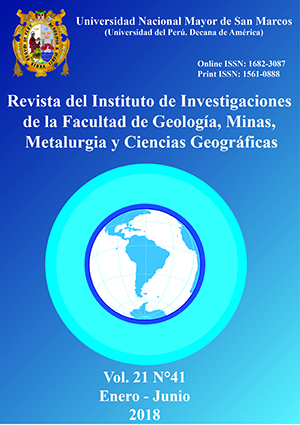Evaluation of the risk of contamination by heavy metals (Hg and Pb) in marine sediments of Estero Huaylá, Puerto Bolívar, Ecuador
DOI:
https://doi.org/10.15381/iigeo.v21i41.14995Keywords:
Mercury concentration, pollution, ecosystems, released lead, heavy metals, marine sediments, freshwaterAbstract
The study of mercury content in marine sediments is presented in nine sampling stations of Estero Huaylá in Puerto Bolívar (Ecuador), by means of spectrophotometry of atomic absorption with flame nebulization and with the generation of hydrides with atomization in a quartz cell. The ecological risk assessment was determined by calculating the pollution factor (fi) and the potential ecological risk index (IREP) at each sampling point. The result obtained, for each metal, was compared with the values of the existing sediment quality guide: CEL (Concentration with limit effect) and CEP (Concentration with probable effect). The results show that the mercury concentration was high in all stations with a minimum of 0.89 and a maximum of 5.79 μg/g, while for the values between 0.04 and 0.09 plomo were obtained μg/g. With respect to toxicological risk, mercury and lead concentration values exceeded the CEL limit value and some mercury values also exceeded the CEP value indicating that mercury more than lead represents a toxicological risk for biota in the sediments of the estuary Huaylá. With respect to the value of the pollution factor, all the points were diagnosed as highly contaminated by mercury, while for the lead, no significant concentrations were detected with the quantification method used. The potential ecological risk index, considering mercury, revealed three highly contaminated sites, five heavily polluted and one moderately polluted. In contrast, for lead, all sampling points are below the allowed limits. The points with the highest concentration of mercury and the highest risk of contamination were those located near the fertilizer and lime distribution companies for shrimp farms and near gas stations. In conclusion, the Huaylá estuary has high concentrations of mercury in its sediments, probably due to the outflow of water from the gold mining activity in the area that is transferred by the intertidal currents from the Santa Rosa estuary to the Huaylá estuary. The urgent need to establish reference values in the Ecuadorian environmental standard is highlighted because it does not contemplate mercury limits for marine and / or freshwater sediments.Downloads
Published
Issue
Section
License
Copyright (c) 2018 Víctor González, Sonia Valle, Mauro Nirchio, Jesús Olivero, Lesly Tejeda, Juan Valdelamar, Fredis Pesantes, Katherine González

This work is licensed under a Creative Commons Attribution-NonCommercial-ShareAlike 4.0 International License.
AUTHORS RETAIN THEIR RIGHTS:
a. Authors retain their trade mark rights and patent, and also on any process or procedure described in the article.
b. Authors retain their right to share, copy, distribute, perform and publicly communicate their article (eg, to place their article in an institutional repository or publish it in a book), with an acknowledgment of its initial publication in the Rev. Inst. investig. Fac. minas metal cienc. geogr.
c. Authors retain theirs right to make a subsequent publication of their work, to use the article or any part thereof (eg a compilation of his papers, lecture notes, thesis, or a book), always indicating the source of publication (the originator of the work, journal, volume, number and date).






